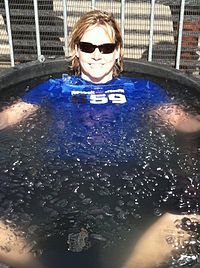
Photo from wikipedia
Abstract The aim of the study was to determine the effects of a 6-month training cycle on muscle damage and inflammatory markers in youth male soccer players. Twenty-one soccer players… Click to show full abstract
Abstract The aim of the study was to determine the effects of a 6-month training cycle on muscle damage and inflammatory markers in youth male soccer players. Twenty-one soccer players were tested four times: at the beginning (T1) and immediately after the pre-season period (T2), in the middle (T3) and at the end of the competitive period (T4). Muscle damage and inflammatory markers were determined in blood taken 36 hours after the match. Throughout the training cycle significant increases (p < 0.05) of creatine kinase (T1: 254.4 U·L-1; T4: 304.2 U·L-1) and lactate dehydrogenase (T1: 382.8 U·L-1; T4: 453.2 U·L-1) activities were observed. Significant changes (p < 0.05) in platelet count (T1: 210.5·109·L-1; T4: 234.2·109·L-1), percentage of lymphocyte (T1: 39.80%; T4: 42.97%), monocyte (T1: 6.88%; T4: 9.99%) and granulocyte (T1: 53.32%; T4: 47.05%) as well as in granulocyte-to-lymphocyte (T1: 1.41; T4: 1.17) and lymphocyte-to-monocyte (T1: 6.21; T4: 4.46) ratios were noted. The correlation analysis revealed statistically significant relationships (p < 0.05) between: myoglobin and the percentage of leukocyte subpopulations and the granulocyte to lymphocyte ratio; lactate dehydrogenase and the percentage of monocyte; lactate and leukocyte count. In conclusion, the reported muscle damage and inflammatory markers in T3 and T4 indicate the need for fatigue status monitoring in youth soccer players, especially in the competitive period. Moreover granulocyte to lymphocyte and lymphocyte to monocyte ratios proved to be sensitive to fatigue changes and therefore can provide coaches and sport scientists with a broader perspective on the biochemical monitoring of training status in soccer players.
Journal Title: Journal of Human Kinetics
Year Published: 2021
Link to full text (if available)
Share on Social Media: Sign Up to like & get
recommendations!